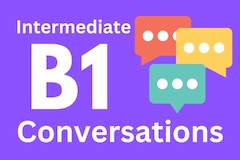Fit Girlfriend
Listen about a man talk about how his girlfriend is very fit.
Meg: Hey, Todd. I was talking to your girlfriend and she seems really fit.
Todd: Yeah. She's very fit. It's kind of a problem actually.
Meg: Oh really? Why?
Todd: Well, she watches what she eats and she's very careful about the food she eats. So she doesn't eat meat, she doesn't eat fast food. She doesn't eat sugar. She doesn't drink coffee. So because she doesn't eat or drink all these foods, it's kind of hard if we go out to dinner or if I want to eat something because then I feel guilty.
Meg: Do you also not eat those foods?
Todd: No. Are you kidding? I mean, I always eat fast food and I love to eat sweets and stuff like that. So we both love exercise, right. So she exercises a lot. I exercise a lot. She exercises more than I do but yeah, the diet thing is kind of a hassle.
Meg: Hmm.
Todd: So what do you think I should do?
Meg: Maybe you should also try to be healthy because it sounds like a good idea.
Todd: Yeah, maybe. I'll give it a try. But the thing is, you know, she – there's one other problem. She eats five small meals a day, so never eats big meals. So we can't go to a restaurant and stuff like that. So it's just really hard to adjust. I mean, I love a big breakfast, you know. She never eats a big breakfast. She always eats these small little meals, so yeah.
Meg: Well maybe, you can cook at home together.
Todd: Maybe. Or maybe I should just get a new girlfriend.
Meg: Maybe. Good luck.
Present Simple - Third Person Singular
- Bob is my boss. He helps me a lot.
- Suzy has a nice car, but she never drives it to work.
- My phone does not take pictures. It does not have camera.
- This pizza tastes great. It has a lot of calories though.
- Larry loves videos games. He plays them every night.
- Sue walks to work. She listens to podcasts as she walks.
- My phone needs a new charger. It costs 40 dollars.
- She does not work nights.
- She doesn't work nights.
- He does not travel much.
- He doesn't travel much.
- It does not snow much in my town.
- It doesn't snow much in my town.
- When does the train leave? / It leaves a six.
- What does your mom want for her birthday? / She wants a cat.
- How does your wife get to work? / She takes the bus.
- Why does he always look angry? / He has a lot of stress
- Who lives here? / My friend lives here.
- What costs a lot of money? / College costs a lot of money.
- Who talks to you every day? / My dad talks to me every day.
- What takes up a lot of your time? / Driving to work does.
- Does he work here? / Yes, he does. / No, he doesn't. (does not)
- Does she have a nice house? / Yes, she does. / No, she does not.
- Does it rain much in your town / Yes, it does. / No, it does not.

















